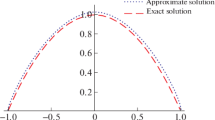Abstract
For an elliptic equation of the second order with variable discontinuous coefficients and the right side, a scheme of the fourth order of accuracy is constructed. On the jump line, the docking conditions (Kirchhoff) are assumed to be satisfied. The use of Richardson’s extrapolation, as the numerical experiments show, increases the order of accuracy to about the sixth order. It is shown that relaxation methods, including multigrid methods, are applicable to solve such systems of linear algebraic equations (SLAEs) corresponding to a compact finite-difference approximation of the problem. In comparison with the classical approximation, the accuracy increases by a factor of about 100 with the same complexity. Various variants of the equation and boundary conditions are considered, as well as the problem of determining the eigenvalues and functions for a piecewise constant coefficient of the equation.
























Similar content being viewed by others
REFERENCES
V. T. Zhukov, N. D. Novikova, and O. B. Feodoritova, “Multigrid method for elliptic equations with anisotropic discontinuous coefficients,” Comput. Math. Math. Phys. 55, 1150–1163 (2015). https://doi.org/10.1134/S0965542515070131
V. M. Babich, “Skin-phenomenon in the case of a wire with arbitrary cross-section,” Zap. Nauchn. Sem. LOMI 128, 13–20 (1982).
O. A. Ladyzhenskaya and N. N. Ural’tseva, Linear and Quasilinear Elliptic Equations (Nauka, Moscow, 1967; Academic, New York, 1968).
Sh. E. Mikeladze, “On the numerical integration of equations of elliptic and parabolic types,” Izv. Akad. Nauk SSSR. Ser. Mat. 5 (1), 57–74 (1941).
P. H. Cowell and A. C. D. Crommelin, Investigation of the Motion of Halley’s Comet from 1759 to 1910. Appendix to Greenwich Observations for 1909 (Neill & Company, Edinburgh, 1910), pp. 1–84.
B. V. Noumerov, “A method of extrapolation of perturbations,” Mon. Not. R. Astron. Soc. 84, 592–601 (1924). https://doi.org/10.1093/mnras/84.8.592
E. Hairer, S. P. Nørsett, and G. Wanner, Solving Ordinary Differential Equations. I. Nonstiff Problems (Springer, New York, 1987).
V. A. Gordin and E. A. Tsymbalov, “Compact difference scheme for the differential equation with piecewise-constant coefficient,” Mat. Model. 29, 16–28 (2017).
V. A. Gordin, How to Count it? Processing of Meteorological Information on a Computer: Ideas, Methods, Algorithms, Problems (MCCME, Moscow, 2005) [in Russian].
M. M. Krasnov, “Parallel algorithm for computing points on a computation front hyperplane,” Comput. Math. Math. Phys. 55, 140–147 (2015). https://doi.org/10.1134/S0965542515010133
A. A. Samarskii and E. S. Nikolaev, Numerical Methods for Grid Equations, Vol. II: Iterative Methods (Nauka, Moscow, 1978; Birkhäuser, Basel, 1989).
R. P. Fedorenko, “A relaxation method for solving elliptic difference equations,” USSR Comput. Math. Math. Phys. 1, 1092–1096 (1962). https://doi.org/10.1016/0041-5553(62)90031-9
R. P. Fedorenko, Introduction to Computational Physics (Intellekt, Dolgoprudnyi, 2008) [in Russian].
A. Iserles, A First Course in the Numerical Analysis of Differential Equations (Cambridge University Press, Cambridge, 2009). https://doi.org/10.1017/CBO9780511995569
V. T. Zhukov and O. B. Feodoritova, “On development of parallel algorithms for solving parabolic and elliptic equations,” J. Math. Sci. 254, 606–624 (2021). https://doi.org/10.1007/s10958-021-05329-y
ACKNOWLEDGMENTS
We thank the reviewer for his useful remarks.
Funding
The publication was prepared with the partial support from a grant (no. 20-04-021) of the Program “Scientific Foundation of the National Research University Higher School of Economics” and with the partial support of the Federal Service for Hydrometeorology and Environmental Monitoring of the Russian Federation (topic АААА-А20-120021490079-3).
Author information
Authors and Affiliations
Corresponding authors
Ethics declarations
The authors declare that they have no conflicts of interest.
APPENDIX
APPENDIX
1.1 Bad Stencils for a Compact Approximation
In the main text of the article, “successful” stencils and coefficients of a compact approximation of the problem are presented. However, with other (sometimes more natural) stencils, implementation barriers can arise:
(i) When determining the coefficients of operators A and P, the corresponding SLAE of order N turns out to be degenerate.
(ii) The large matrix \(\mathcal{A}\) turns out to be ill-conditioned. This usually manifests itself in violation of its property of negative definiteness.
We give examples of such pairs of stencils and indicate which of the two types of problem is observed.
(i) We choose the following stencils (see Figs. 2, 25): cross for the function u and square for the right side of f, i.e., \({{\nu }_{A}} = 5\), \({{\nu }_{P}} = 9\).
Taking into account the symmetry of the problem, we obtain for an arbitrary internal node of a two-dimensional grid with numbers \(i,j\) a linear algebraic equation with as yet undetermined coefficients \(p,q,r\):
To determine these coefficients, we require the exact fulfillment of Eq. (A.1) on the following pairs of test functions:
Equations (3) and (4) contradict each other. Therefore, in the specified stencil, a fourth-order scheme is impossible.
(ii) The case of degeneration or ill-conditioning of the global matrix \(\mathcal{A}\). If we decide not to use the left and right limits of the right part of \({{f}_{ + }}\) and \({{f}_{ - }}\) on line Γ and assume that function f is not defined there (the stencil coefficients for the right side when approximating the equation there are 0), then it is not possible to choose a stencil for points on line Γ such that the fourth order of approximation would be provided and condition (9) would be satisfied. This circumstance often led to ill conditionality of the global matrix \(\mathcal{A}\). An example of a “bad” stencil for points of type B is shown in Fig. 26. The test functions for this stencil are the same as in Eq. (4) and the normalization condition: a = 1. Solving the SLAE, we obtain the coefficients of the scheme, and \(e1,e2,d1\), \(d2 > 0\). Therefore, condition (9) is not satisfied. The numerical experiments indeed show the ill conditionality of the global matrix \(\mathcal{A}\).
Rights and permissions
About this article
Cite this article
Gordin, V.A., Shadrin, D.A. Compact Approximation of a Two-Dimensional Boundary Value Problem for Elliptic Equations of the Second Order with a Discontinuous Coefficient. Math Models Comput Simul 15, 920–943 (2023). https://doi.org/10.1134/S2070048223050046
Received:
Revised:
Accepted:
Published:
Issue Date:
DOI: https://doi.org/10.1134/S2070048223050046





